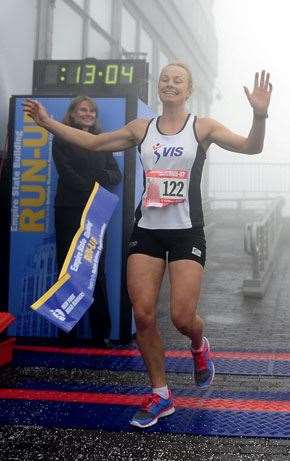Hands up those who ran to beat the closing lift doors on their way up to their fifth-floor office suite this morning?
 All that rowing training paid off for Alice McNamara. Images: Joseph Feil
All that rowing training paid off for Alice McNamara. Images: Joseph FeilERGO-NOMICAL
“The ergometer is the rowing machine. We call it the ‘ergo’. You’ve probably seen it in gyms, but we tend to do sessions on it: 15-minute pieces or 20-minute blocks. The ergometer has set ratings or speeds which you’re meant to sit on.
“My coach at the VIS, Bill Tait, sent me a text message the night before the Empire State Building race saying, ‘Remember when you get to level 40, that lactic is so familiar and you love it.’ It’s true – our racing in rowing is over seven-to-eight minutes for lightweight scullers, so we train for seven-minute races, but a lot of the work we do is for 15-20-minute peaks on the water and on the ergo. We’re used to tolerating a high amount of lactic for about the time it takes to win the Empire State race.”
IN THE GYM
“We stick to mainly strength-based training in the gym for most of the year. For me, my strength weight sessions consist of four exercises – squats, powercleans, benchpulls and benchpresses. There’ll predominately be four-five sets of five-eight reps. We try and build muscle strength without adding bulk. My strength coach at the VIS, Harry Brennan, will throw in counter-sets, where, if I do squats, I’ll follow with box jumps, or single-leg explosive leg drives onto the box. So you might be on one leg and you’ll drive your other knee up and come up jumping.”
AND THEY’RE OFF
“Everyone who’s raced the Empire State Building Run-Up in the past is seeded. I was actually 22. The top ten are placed at the front, meaning I started in the middle of the second row. As they were marshalling people, because I had watched the Youtube video from the year before, I saw the chaos at the start and thought, ‘I’ve got to get to the stairwell so I don’t have to wait at the bottom while everybody sorts themselves out; there’s a risk of falling behind two flights of stairs.’ I thought, ‘I’m going to edge myself to the side, so I can be in the second row, but then edge my way almost to the first row.’ As the gun went off, I was gone!”
IN THE STAIRWELL
“You’re working at a high level aerobically; probably 85 per cent intensity. Everyone is going at a pretty quick pace. You have to make one big swift move to go around someone. You can’t just sit next to them and pace yourself; you’d be covering extra distance from going around the outside of the stairwell. What I did was make a bee-line for an Aussie girl at the start who had won the race a few years before. I thought, ‘I’ll sit behind her for a few levels and just go with the pace.’ There were two girls in front of her, so we were probably sitting about third and fourth, or fourth and fifth. They were edging away, and I thought, ‘I’m going to have to make a move around the Aussie girl or I’m going to lose contact with the girls in front.’ This was probably in the first 20 levels.
“On the landings the runners had a bit of an advantage, but I backed myself on the stairs. I just did a sprint, two stairs at a time, to lunge around the Aussie, then quickened my pace up towards the next girl. Then I sat behind her for a couple of levels. At about level 30 I ran around her. Around about 36-37, I passed another girl. I put my head down and lunged past her.
“When I got to half-way, I wasn’t sure whether I was in the lead. I thought there might have been one girl still ahead of me. I didn’t know until ten floors to go, when one of the marshals said, ‘You’re coming first in your category,’ so I kind of knew I was in the lead from then. From about half-way on, I just had to ‘rhythm’ it.”
Related Articles

Magnificent seven? Scheffler plays down career slam

Allan goes wire-to-wire for second Champions Tour win













